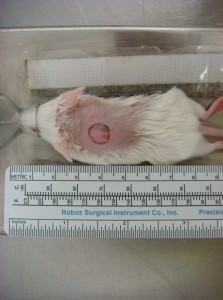Performance of dorsal mouse wounds in preliminary and full experiments
There are two major disadvantages to this model, but one should also note some potential
opportunities. Fig. 2 shows a typical dorsal mouse wound performed by our group.

Fig. 2.This dorsal wound was created on the back of a beige SCID mouse for one of our experiments to test the topical application of bone marrow-derived cultured human mesenchymal stem cells (MSCs). In cases where an immunocompromised state is not required, any strain can be used. Hairless mice are available. With typical and economical C57BL/6 mice, the shaved hair regrows rapidly, within 2-3 days. These dorsal wounds contract and close within 7-9 days.
Depending on the mouse strain, the hair is shaved or removed by chemical depilatories. In
some cases, bilateral wounds are created. The latter is a common approach, but we believe the
wounds should receive the same treatment or experimental approach.. Closure of the wounds is measured after adequate hair removal. The macroscopic findings of continuous wound closure are confirmed by histology. Ink marking of the widest diameter of the wound at baseline can help when relying on histological findings. This allows one to section the specimen more reliably.
The disadvantages of dorsal wounds are the following: i) the degree of contraction is much
more than what is generally observed in human wounds. ii) in spite of careful and assiduous
shaving of the hair, one observes hair re-growth within 2-3 days, to the point that in most strains
of mice it becomes difficult to even see the site of injury. iii) the “window” of observation for wound closure is relatively short, in the range of 7-9 days.